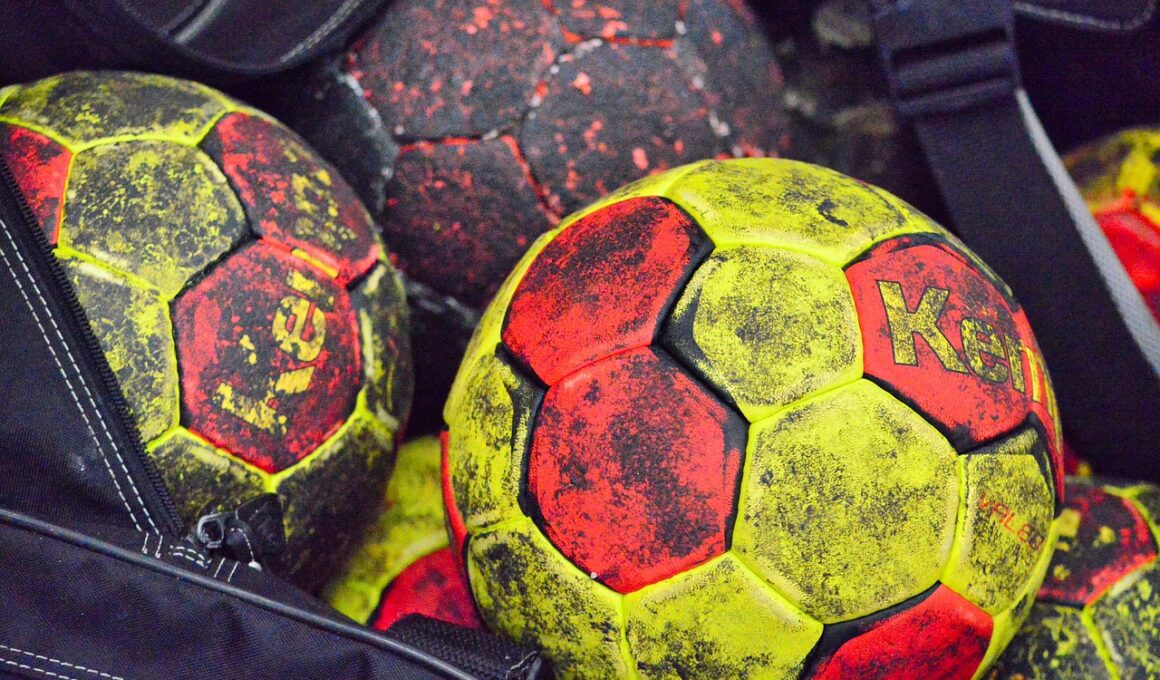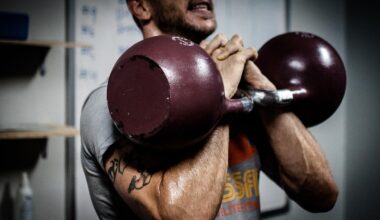The Influence of Surface Type on Upper Limb Biomechanics in Handball
Biomechanics significantly impacts athletic performance, particularly in sports like handball. The type of surface athletes play on can alter the mechanics of their movements, which has implications for performance and injury risk. Different surfaces—such as hardwood, synthetic, and turf—affect how joints absorb forces and how muscles are utilized. Research indicates that the friction, cushioning, and resilience of surfaces interact with biomechanics. Handball players engage in rapid movements, requiring precise motor skills. Understanding the surface effects on upper limb biomechanics can optimize training, minimize injuries, and enhance performance. Surface type influences the way force is transmitted through the arms during throwing, passing, and catching actions. In addition, the stability provided by different surfaces can influence how well players can control their body movements and maintain balance while executing techniques. Ultimately, coaches and athletic trainers should consider the effects of surface types in their training regimens. This knowledge allows for informed decisions regarding training conditions, thereby improving athletic performance while reducing injury incidences significantly. Studying these dynamics can lead to tailored training programs that account for surface-related biomechanical principles.
In handball, upper limb biomechanics plays a crucial role in both offensive and defensive strategies. Understanding how various surfaces affect upper limb action can guide players in adapting their techniques accordingly. Athletes often demonstrate distinctive adaptations based on surface properties, highlighting the significance of biomechanics in performance. For instance, on synthetic courts, players may rely more on arm movements due to enhanced traction compared to slippery surfaces. Enhanced traction enables players to execute powerful throws with greater precision and speed. When transitioning to less stable surfaces like turf, the mechanics may change, potentially increasing strain on the upper limb. Given the high intensity of handball, analyzing movement on diverse surfaces is essential. Surface disparities can lead to unique biomechanical demands that prompt changes in arm angles, velocity, and follow-throughs. Players need to understand their movements on each surface type to optimize their performance in this fast-paced, high-impact sport. Additionally, injury prevention must be a focus, as improper adjustments to surfaces may lead to ailments such as tendinitis or shoulder injuries. Therefore, both training practices and injury prevention strategies should prioritize understanding biomechanics in relation to surface types.
Surface Interaction with Motion
The interaction between surface types and motion mechanics is vital for understanding handball performance. When players engage in dynamic movements such as sprinting, jumping, and throwing, the surface they interact with plays a pivotal role in their biomechanics. Friction levels differ across surfaces, influencing force application during these movements. A higher friction surface allows for better grip, aiding a player’s ability to push off when making a pass. Conversely, a slicker surface may require players to adjust their techniques to prevent slips or falls. Players often adjust their biomechanics subconsciously when navigating different surface types, such as modifying their stance or follow-through. These adjustments help to maintain balance and control during play but can vary significantly between players. Moreover, upper limb movements, such as the arm motion used in shooting, rely on optimal surface conditions for maximum effectiveness. Research suggests that these motions are biomechanically efficient only on surfaces that provide adequate feedback and support. Therefore, understanding these biomechanics not only aids performance but can also help reduce injury risks associated with improper footwork and stance on varying playing surfaces.
In handball, the biomechanics of upper limb movement is directly influenced by the player’s technique and the playing surface. Each surface type presents unique characteristics that require players to adjust their biomechanics accordingly. For example, players may alter their arm swings and body alignment based on the ground friction and shock absorption of a surface. When executing a throw, factors such as grip and stability come into play, making it essential to account for surface interactions. Synthetic surfaces often provide a uniform texture, granting athletes better control and enhanced performance during throwing motions. Tips for optimizing performance on these surfaces include focusing on body positioning and arm trajectory. Conversely, playing on natural surfaces such as grass can present challenges that necessitate players to modify their strategies. Adjusting throwing techniques appropriately is crucial to maintaining accuracy and power while mitigating injury risks. Coaches and trainers should incorporate drills specific to these surface types into practice sessions. This tailored approach allows players to develop the biomechanical adaptations necessary for success on various surfaces, ensuring they can meet the physical demands of competitive handball across different environments.
Injury Prevention and Performance
Injury prevention is a significant concern in any sport, particularly in dynamic games like handball where upper limb biomechanics are crucial. Understanding how surfaces impact biomechanics can help reduce injury risks among athletes. Studies indicate that playing on harder surfaces can lead to repetitive strain injuries in shoulders and elbows. For instance, a player who frequently pushes off a tough surface might be at elevated risk for tendinitis due to increased stress on the muscles and joints. Coaches must be aware of these risks when designing training sessions or choosing surfaces for practice. Incorporating surface variability into training can help players develop resilience and adaptability. Additionally, preparing athletes with strength and flexibility training focused on the upper limbs is essential in minimizing injury risks. Techniques can include strengthening shoulder stabilizers to withstand the demands of different surfaces. If players adapt to various surfaces effectively, they can enhance their overall resilience. Performance optimization, combined with injury prevention, ensures athletes can compete at higher levels while safeguarding their health. Understanding the intricate relationship between surface type, biomechanics, and injury risk is vital for any handball program.
Furthermore, analyzing the impact of surface types extends beyond immediate performance concerns; it has long-term implications for an athlete’s career. Players may develop compensatory mechanics on certain surfaces, leading to chronic issues if not addressed. This is particularly true for handball, where upper limb dynamics are utilized extensively for shooting and passing. Coaches should monitor players’ techniques closely on different surfaces to identify any changes in biomechanics that may indicate risk. Regular assessments can assist in detecting patterns that lead to overuse injuries, allowing for timely interventions. Adapting training regimens and providing appropriate rest periods is crucial for maintaining athlete health. Agility drills and plyometrics should also consider surface influences to maximize benefits while minimizing strain on players’ joints. The feedback researchers provide regarding biomechanical performance on various surfaces is essential for developing effective training programs in handball. By proactively addressing biomechanical issues related to surface type, teams can foster an environment of safety and sustained performance. This holistic approach not only enhances individual skills but also contributes to the longevity of an athlete’s career in the competitive landscape of handball.
Conclusion
In conclusion, understanding the influence of surface type on upper limb biomechanics is essential in handball. Different surfaces create distinct biomechanical demands that can significantly impact player performance and injury risk. Coaches and athletes alike must recognize these dynamics to optimize training strategies and minimize injuries effectively. Adjustments to techniques and movements based on surface type can enhance agility, precision, and control, ultimately benefiting players during competition. Additionally, integrating surface variability into practice plans allows athletes to build adaptability and resilience. Educating players about their biomechanics on various surfaces can empower them to make informed decisions during play. Performance enhancements gained from understanding these principles can lead to improved outcomes on the court. Furthermore, the long-term health of athletes can be safeguarded by actively managing injury risks associated with surface interactions. As the sport of handball continues to evolve, further research into biomechanics will enhance our approach to training and competition. Embracing a comprehensive understanding of the interplay between surface types and biomechanics will ensure the growth and success of handball athletes in a competitive environment.
Ultimately, the ongoing investigation into the role surface type plays in upper limb biomechanics is crucial for optimizing performance and ensuring athlete safety. Each surface presents distinct challenges that require careful consideration, effective training strategies, and targeted injury prevention practices. By fostering a strong relationship between biomechanics and surface interaction, athletes can unlock their true potential in handball. Coaches and trainers must remain vigilant in adapting training programs that reflect these underlying principles, ensuring players can thrive under various conditions. A proactive approach that prioritizes both performance and injury risk management will lead to better athlete outcomes. Further studies can illuminate the complexities of these interactions, aiming to refine understanding and enhance training methodologies in handball. Continuous improvement in the field of biomechanics will undoubtedly contribute to the overall growth of the sport. Consequently, researchers should continually seek new evidence to inform best practices across varying surface types. As knowledge expands, so too does the potential for athletes to excel while minimizing injury risks, ensuring a safer and more effective playing environment for handball participants.


